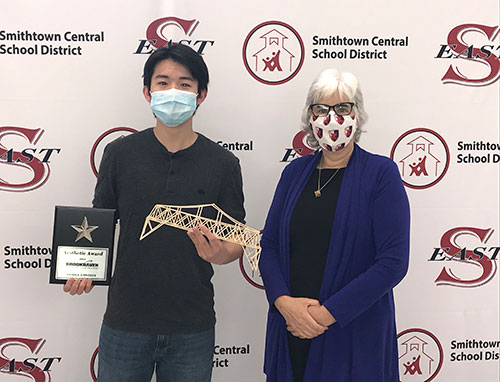Brookhaven Lab Honors Top Students in Bridge and Maglev Contests
Long Island students competed remotely in two competitions that promote hands-on STEM skills
May 5, 2021
 enlarge
enlarge
Katherine Liang of Paul J. Gelinas Junior High School with the bridge that earned her first place in the annual Bridge Building Contest. (Courtesy photo)
UPTON, NY–The Office of Educational Programs (OEP) at the U.S. Department of Energy’s Brookhaven National Laboratory announced local students who earned the top spots in both the 2021 Bridge Building Contest and 2021 Maglev Competition during an online awards ceremony on Friday, April 16.
Each competition, held virtually this year, offers students a hands-on opportunity to apply math, science, and technology principles as they design and build bridges and magnetic levitation cars.
“Conceiving, designing, and building the one-of-a-kind facilities at Brookhaven National Laboratory takes extraordinary vision on the part of our scientists and our engineers to advance our science mission,” said OEP Manager Kenneth White. “These two competitions test the design and analytical skill of contestants to create bridges and vehicles to exacting specifications and performance expectations much like our facilities demand of our staff. We hope some of these contestants will be our staff one day to take on another engineering challenge supporting extraordinary discoveries.”
Watch as Brookhaven Lab staff put student-made bridges to the test.
Bridge Building Competition
In the annual Bridge Building Contest, high school students became engineers competing to construct the most efficient model bridge out of lightweight wood. Efficiency is calculated from the bridge’s weight and the weight the bridge can hold before breaking or bending more than one inch. The higher the efficiency, the better the design and construction.
Dedicated Brookhaven Lab staff engineers and technicians tested 40 qualifying structures during a live online event on April 8.
Katherine Liang, a 9th grade student of Paul J. Gelinas Junior High School earned first place with a bridge that weighed 18.7 grams, supported 38.6 pounds. The bridge earned an efficiency of 936.29.
For some students, a trial-and-error process was key to solidifying a design. Liang said she built and tested five bridges by weighing them down with a bucket of sand before submitting her final winning structure.
Second place went to David Liang of Ward Melville High School, whose bridge weighed 19 grams, held 36.4 pounds had an efficiency of 868.98.
Victor Prchlik, also from Ward Melville High School, placed third with a bridge that weighed 23.7 and supported 44.5 pounds with an efficiency of 851.87
Jonathan Chung of Smithtown East High School won this year’s Aesthetic Award.
“The whole process was fun from start to finish,” Chung said. “One of the most challenging parts was getting the glue to stick the wood together. I ended up solving that problem by using a hairdryer to dry it.”
Brookhaven Lab staff tested magnetic levitation cars built by students from Island Trees Middle School and Bay Shore Middle School to see who came up with the fastest design.
 enlarge
enlarge
This year's Aesthetic Award Jonathan Chung of Smithtown East High School with physics teacher Dr. Gillian Winters. (Courtesy photo)
MAGLEV Contest
This year’s Maglev Contest for 6th, 7th, and 8th grade students included two main categories for speed and appearance. Brookhaven Lab staff tested 21 maglev cars for speed on a fixed gravity track–13 of which reached the finish line.
Brady Leichtman of Bay Shore Middle School won first place in the speed category.
Second place went to Isabella Rouleau of Bay Shore Middle School.
Jesse Bonura of Island Trees Middle School placed third and also won the top spot in the competition’s appearance category with a futuristic blue car.
Bay Shore Middle School students Amber Marquez and Andrea Romero, placed second and third in the appearance category, respectively.
Brookhaven Lab staff tested magnetic levitation cars to see who came up with the fastest design.
Bonura found that part of the fun was testing and reengineering the maglev’s design.
“We’d make it quicker and test it over and over again to make it perfect,” Bonura said.
The maglev contest is based on research by two Brookhaven engineers, the late Gordon Danby and James Powell, who invented and patented maglev technology—the suspension, guidance, and propulsion of vehicles by magnetic forces.
Magnetic properties give the maglev trains their extraordinary capabilities for speed and stability. These same principles—using magnetic forces to move matter — are used in world-class research facilities at Brookhaven Lab, including the Relativistic Heavy Ion Collider (RHIC) and the National Synchrotron Light Source II (NSLS-II) — which are both DOE Office of Science user facilities. Magnetic properties allow the machines to move particles at nearly the speed of light for research purposes.
Brookhaven National Laboratory is supported by the U.S. Department of Energy’s Office of Science. The Office of Science is the single largest supporter of basic research in the physical sciences in the United States and is working to address some of the most pressing challenges of our time. For more information, visit https://energy.gov/science.
Follow @BrookhavenLab on Twitter or find us on Facebook.
2021-18825 | INT/EXT | Newsroom











